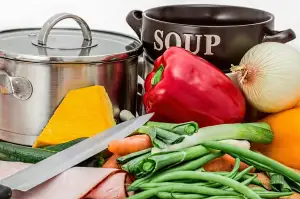Master the Art of Roasting a Turkey: A Delicious Guide to Perfectly Cooked Poultry

- Selecting the Perfect Turkey
- Preparing the Turkey for Roasting
- Seasoning and Flavoring the Turkey
- Preheating the Oven
- Roasting the Turkey
- Monitoring the Cooking Process
- Basting the Turkey
- Checking for Doneness
- Letting the Turkey Rest
- Carving and Serving the Roasted Turkey
- Tips and Tricks for a Perfectly Roasted Turkey
Roasting a turkey is a culinary art that brings joy and satisfaction to any festive occasion. The golden brown skin, tender meat, and enticing aroma make it the centerpiece of a memorable meal. Whether you are hosting Thanksgiving dinner or simply craving a delicious roast, mastering the art of roasting a turkey is essential. In this guide, we will take you through each step, from selecting the perfect turkey to carving and serving it with finesse. So, get ready to embark on a mouthwatering journey as we explore the secrets to achieving a perfectly roasted turkey that will leave your guests begging for seconds.
Selecting the Perfect Turkey
When it comes to roasting a turkey, choosing the right bird is crucial. Look for a fresh or frozen turkey that is plump and has a smooth, creamy-white skin. The size of the turkey will depend on the number of guests you are serving, but as a general rule, plan on about 1 pound per person.
Consider whether you want a whole turkey or just specific parts like breast or legs. Whole turkeys are great for large gatherings and provide leftovers for sandwiches and soups. If you prefer white meat, opt for a turkey breast. For those who enjoy dark meat, go for turkey legs.
It's also important to consider the quality of the turkey. Look for turkeys that have been raised without antibiotics or hormones for a healthier option. Organic or free-range turkeys are often more flavorful and have better texture.
Lastly, check the packaging date to ensure freshness if buying a fresh turkey. If purchasing a frozen one, make sure it has been properly stored at freezing temperatures.
By selecting the perfect turkey, you're setting yourself up for success in creating a delicious roasted centerpiece that will leave your guests craving more.
Preparing the Turkey for Roasting
Before you can begin roasting your turkey, it's important to properly prepare it. Start by removing the giblets and neck from the cavity of the turkey. These can be used to make a flavorful gravy later on. Rinse the turkey inside and out with cold water, then pat it dry with paper towels.
Next, truss the turkey to ensure even cooking. Trussing involves tying the legs together with kitchen twine and tucking the wings under the body. This helps to keep the turkey in a compact shape and prevents it from drying out during cooking.
To enhance flavor and moisture, consider brining your turkey. Brining involves soaking the turkey in a saltwater solution for several hours or overnight. This helps to tenderize the meat and infuse it with flavor. If you choose to brine, be sure to rinse off any excess salt before proceeding.
Finally, let your turkey come to room temperature before roasting. Allowing it to sit at room temperature for about an hour will help ensure more even cooking throughout.
By properly preparing your turkey before roasting, you'll set yourself up for success and end up with a deliciously juicy bird that is sure to impress your guests.
Seasoning and Flavoring the Turkey
To enhance the taste of your roasted turkey, seasoning and flavoring are essential steps. Start by generously seasoning the turkey with salt and pepper both inside and out. You can also add herbs like thyme, rosemary, or sage for a fragrant aroma. For a bolder flavor, consider creating a spice rub using paprika, garlic powder, and onion powder. Rub the mixture all over the turkey to ensure even distribution of flavors. Additionally, you can stuff the cavity with aromatic ingredients such as onions, garlic cloves, citrus fruits, or fresh herbs to infuse more flavors into the meat. Experiment with different seasonings and spices to create a unique taste that will leave your guests craving for more!
Preheating the Oven
Before you begin roasting your turkey, it is essential to preheat your oven. Preheating ensures that the oven reaches the desired temperature, allowing for even cooking and a perfectly roasted turkey.
To preheat the oven, set the temperature according to the recipe or cooking instructions. Typically, a turkey is roasted at around 325°F (165°C). Allow the oven to heat up for at least 20 minutes before placing the turkey inside.
During this time, make sure to remove any racks or trays that may obstruct the turkey's placement in the oven. This will ensure proper airflow and an evenly cooked bird.
Remember to adjust your cooking time based on whether you are using a conventional or convection oven. Convection ovens typically cook faster than conventional ones, so be mindful of this when setting your cooking time.
Once the oven has reached the desired temperature, it's time to move on to the next step: roasting the turkey.
Roasting the Turkey
Once your turkey is prepared and seasoned, it's time to roast it to perfection. Preheat your oven to 325°F (165°C). Place the turkey on a rack in a roasting pan, breast side up. This allows for even cooking and crispy skin.
Cover the turkey loosely with aluminum foil to prevent excessive browning. Place the roasting pan in the preheated oven and let the magic begin. The general rule of thumb is to cook the turkey for about 15 minutes per pound (0.45 kg).
During the cooking process, resist the temptation to constantly open the oven door. This can cause temperature fluctuations and affect cooking time. Trust that your turkey is doing its thing inside.
After about two-thirds of the estimated cooking time has passed, remove the foil to allow the skin to brown beautifully. Baste with pan juices or melted butter every 30 minutes for added moisture and flavor.
Continue roasting until a meat thermometer inserted into the thickest part of the thigh registers 165°F (74°C). This ensures that your turkey is cooked through but still juicy and tender.
Remember that larger turkeys may take longer to cook, so plan accordingly. Use a meat thermometer as your guide rather than relying solely on cooking times.
Once done, carefully remove the turkey from the oven and transfer it to a cutting board or serving platter. Tent it loosely with foil and let it rest for at least 20 minutes before carving.
This resting period allows the juices to redistribute throughout the meat, resulting in a moist and succulent bird. Plus, it gives you some time to prepare any finishing touches or side dishes.
Roasting a turkey can be intimidating, but with proper technique and attention to detail, you'll master this art form in no time. So go ahead, gather your loved ones around, carve that perfectly roasted bird, and savor every delicious bite!
Monitoring the Cooking Process
Once the turkey is in the oven, it's important to keep a close eye on its progress. Set a timer to remind yourself to check on it periodically. As the turkey roasts, the aroma will fill your kitchen, building anticipation for the delicious meal ahead.
Check the temperature of the turkey using a meat thermometer inserted into the thickest part of the thigh. This will help you monitor its internal temperature and ensure it reaches a safe minimum of 165°F (74°C) to prevent any foodborne illnesses.
During this time, resist the temptation to open the oven door too frequently as it can cause fluctuations in temperature and extend cooking time. Instead, use your oven light and window to observe without interrupting the cooking process.
If you notice any areas of the turkey browning too quickly or unevenly, you may need to rotate or cover those sections with aluminum foil. This will help distribute heat more evenly and prevent overcooking in certain spots.
Remember that every oven is different, so cooking times may vary slightly. Be patient and trust your instincts as you continue to monitor and adjust as needed. With practice, you'll become more confident in gauging when your turkey is perfectly cooked.
By closely monitoring the cooking process, you'll be able to achieve that golden brown skin and juicy meat that everyone craves.
Basting the Turkey
Basting the turkey is a crucial step in achieving a moist and flavorful bird. To begin, carefully remove the turkey from the oven and close the oven door to maintain heat. Using a baster or spoon, collect the pan juices and gently pour them over the turkey, ensuring all areas are coated. This process helps to keep the meat moist and adds depth to the flavor. Basting should be done every 30 minutes throughout the cooking process. Be sure to work quickly to minimize heat loss from the oven. Remember, each time you open the oven door, it extends the cooking time. So, baste efficiently and get that delicious bird back into the oven!
Checking for Doneness
After hours of patiently roasting your turkey, it's crucial to ensure that it is cooked thoroughly. To check for doneness, you can use a meat thermometer. Insert the thermometer into the thickest part of the turkey's thigh without touching the bone. The temperature should reach 165°F (74°C) to guarantee that it is safe to eat.
If you don't have a meat thermometer, you can also check for doneness by piercing the turkey's thigh with a fork. The juices should run clear, indicating that it is fully cooked. Additionally, the turkey's legs should move easily and separate from the body when gently pulled.
Remember that different parts of the turkey may cook at different rates, so it's important to check multiple areas for consistency. If any part of the bird is not fully cooked, return it to the oven and continue roasting until it reaches the desired temperature.
Once you are confident that your turkey is perfectly cooked, remove it from the oven and let it rest for about 20 minutes before carving. This resting period allows the juices to redistribute throughout the meat, resulting in a moist and flavorful bird.
By following these steps and checking for doneness properly, you can be sure that your roasted turkey will be a delightful centerpiece for your holiday feast.
Letting the Turkey Rest
Once the turkey is cooked to perfection, it's crucial to let it rest before carving. This step allows the juices to redistribute throughout the meat, resulting in a moist and flavorful bird. Carefully remove the turkey from the oven and place it on a cutting board. Tent it loosely with aluminum foil to keep it warm.
Letting the turkey rest for about 20-30 minutes will give you time to prepare other dishes or set the table. During this time, resist the temptation to carve into the turkey right away. Patience is key here! The resting period allows for easier carving and ensures that each slice is succulent and tender.
While resting, take this opportunity to make gravy using the drippings from the roasting pan. This will add an extra layer of deliciousness to your meal. Just remember to strain out any solids before adding them to your gravy.
By allowing your roasted turkey to rest, you'll be rewarded with a mouthwatering centerpiece for your Thanksgiving or holiday feast. So relax, enjoy some quality time with loved ones, and savor every delectable bite of your perfectly cooked poultry.
Carving and Serving the Roasted Turkey
Once your turkey is perfectly cooked, it's time to carve and serve this delectable centerpiece. Follow these steps to ensure a beautiful presentation:
1. Let the turkey rest for at least 20 minutes before carving. This allows the juices to redistribute, resulting in a moist and tender bird.
2. Place the rested turkey on a cutting board with a well to catch any drippings.
3. Begin by removing the legs and thighs, cutting through the joints where they meet the body. Separate them further if desired.
4. Next, slice along the breastbone to separate each side of the breast meat from the carcass.
5. Slice the breast meat into thin, even slices against the grain for maximum tenderness.
6. Arrange all the carved pieces on a platter, garnishing with fresh herbs or citrus slices for an elegant touch.
7. Serve alongside traditional Thanksgiving sides like stuffing, cranberry sauce, and roasted vegetables.
Remember to savor every bite of this succulent turkey that you've worked so hard to prepare. Enjoy this delightful feast with your loved ones and create lasting memories around a table filled with delicious food!
Tips and Tricks for a Perfectly Roasted Turkey
1. Use a meat thermometer to ensure the turkey is cooked to perfection. Insert it into the thickest part of the thigh, and when it reaches 165°F (74°C), your turkey is ready.
2. To prevent the breast from drying out, cover it with foil during the first half of cooking time. This will help retain moisture and result in juicy meat.
3. For a beautifully browned skin, brush melted butter or olive oil over the turkey before roasting. You can also sprinkle herbs or spices on top for added flavor.
4. Consider brining your turkey before roasting. This process involves soaking the bird in a saltwater solution overnight, which enhances its juiciness and tenderness.
5. Don't forget to let your turkey rest for at least 20 minutes after removing it from the oven. This allows the juices to redistribute throughout the meat, resulting in a more flavorful and moist bird.
6. If you want crispy skin all around, roast your turkey on a wire rack set inside a baking sheet. This ensures even air circulation and prevents any areas from becoming soggy.
7. Add aromatics like onions, garlic, citrus fruits, or herbs inside the cavity of the turkey before roasting. These will infuse delicious flavors into the meat as it cooks.
8. Tenting your turkey with foil towards the end of cooking time can help prevent over-browning while allowing it to continue cooking until done.
Remember, practice makes perfect! Don't be afraid to experiment with different seasonings and techniques until you find your own signature roasted turkey recipe that will impress everyone at your table.
After all the effort and anticipation, it's finally time to savor your perfectly roasted turkey. Gather your loved ones around the table and let the aroma of the succulent meat fill the air. As you carve into the tender, juicy flesh, take a moment to appreciate the golden-brown skin that is crispy and full of flavor.
Pair your roasted turkey with traditional sides like creamy mashed potatoes, tangy cranberry sauce, and savory stuffing. The combination of flavors will create a symphony on your taste buds that will leave you craving for more.
Remember to save any leftover turkey for sandwiches or use it in hearty soups and stews. The versatility of this dish ensures that you can enjoy its deliciousness even after Thanksgiving Day.
Roasting a turkey may seem daunting at first, but with practice and these helpful tips, you'll soon master the art of creating a perfectly cooked poultry masterpiece. So go ahead, unleash your inner chef, and delight in the joy of sharing a mouthwatering roasted turkey with your loved ones.
Published: 30. 11. 2023
Category: Food



